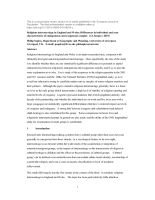Religious Intermarriage in England and Wales: Differences in Individual and Area Characteristics of Endogamous and Exogamous Couples
Author(s)
Publication Name
Publication Date
Abstract
Religious intermarriage in England and Wales is an under-researched area, compared with ethnically divergent and immigrant/host intermarriage. More specifically, the aim of the study is to identify whether there are any statistically significant differences in personal or spatial characteristics between religiously endogamous and exogamous couples, and if so, to provide some explanation as to why. Use is made of the responses to the religion question in the 2001 and 2011 censuses and the Office for National Statistics (ONS) longitudinal study, so as to avoid bias inherent in trying to establish random survey samples of minor-religion members and their partners. Although the paper considers religious intermarriage generally, there is a focus on Jews as the only group which demonstrates a high level of stability of religion reporting and material levels of exogamy. Logistic regression indicates that Jewish population density, start decade of the partnership and whether the individuals are in work and live in an area with a large synagogue are statistically significant differentiators that have a material impact on levels of exogamy and endogamy. A strong link between exogamy and cohabitation (and delayed childbearing) is also established for this group. Some comparisons between Jews and religiously intermarried groups in general are also made, and the utility of the ONS longitudinal study for examination of small groups is established.
Topics
Genre
Geographic Coverage
Copyright Info
Pre-publication draft courtesy of the author
Original Language
DOI
Link
Link to article (paywalled), Religious Intermarriage in England and Wales: Differences in Individual and Area Characteristics of Endogamous and Exogamous Couples
Bibliographic Information
Religious Intermarriage in England and Wales: Differences in Individual and Area Characteristics of Endogamous and Exogamous Couples. 2019: https://archive.jpr.org.uk/10.1007/s10680-019-09534-z




